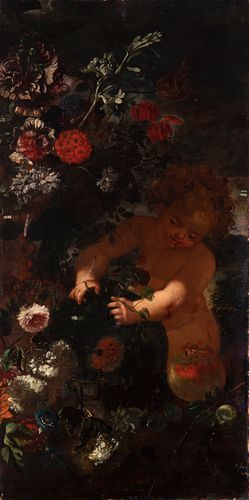Neapolitan school; late seventeenth century. "A Child with flowers and fruits". Oil on canvas. Re-framed.
Lot 55
About Seller
Setdart Auction House
Carrer Aragó 346
Barcelona
Spain
Setdart Subastas was born in 2004 and is currently the first online art auction in Spain with solidity, prestige and reliability guaranteed by our more than 60,000 users. Setdart has a young, dynamic and enterprising team ready to successfully manage the purchase and sale of art works through custom...Read more
Estimate:
EUR€2,000 - EUR€2,500
$2,150.54 - $2,688.17
Absentee vs Live bid
Two ways to bid:
- Leave a max absentee bid and the platform will bid on your behalf up to your maximum bid during the live auction.
- Bid live during the auction and your bids will be submitted real-time to the auctioneer.
Bid Increments
| Price | Bid Increment |
|---|---|
| EUR€0 | EUR€10 |
| EUR€200 | EUR€25 |
| EUR€500 | EUR€50 |
| EUR€1,000 | EUR€100 |
| EUR€3,000 | EUR€200 |
| EUR€5,000 | EUR€500 |
| EUR€10,000 | EUR€1,000 |
| EUR€20,000 | EUR€2,000 |
| EUR€50,000 | EUR€5,000 |
About Auction
By Setdart Auction House
Jul 14, 2021
Set Reminder
2021-07-14 06:30:00
2021-07-14 06:30:00
America/New_York
Bidsquare
Bidsquare : OLD MASTERS
https://www.bidsquare.com/auctions/setdart-auction-house/old-masters-7202
Setdart Auction House sofia@setdart.com
Setdart Auction House sofia@setdart.com
- Lot Description
Neapolitan school; late seventeenth century. "A Child with flowers and fruits". Oil on canvas. Re-framed. Presents loose frame, pictorial losses. Size: 111 x 56 cm; 117 x 62,5 cm (frame). The scene of vertical format shows us a little love located in the right zone of the composition, which is invaded by a group of flowers. Among this vegetation stands out the pomegranate, symbol of rebirth, both in classical iconography, characteristic element of Persephone, and in the Christian religion, symbol of passion, resurrection and even chastity. It is likely that this work has a deeper allegorical meaning, a second reading that speaks of abundance and youth. Allegorical portraits emerged from the Middle Ages with the intention of exalting the qualities and situations of life. This type of works were used to exalt the qualities of a character. In the representation dominates the composition of the image an effective illumination, very studied and contrasted, based on a tenebrist spotlight, an artificial light that falls directly on the most prominent areas of the composition, leaving the rest in semi-darkness and highlighting the figure with great three-dimensionality and naturalism. The palette used revolves around greenish, ochre and carmine tones, bringing warmth to the scene, very elaborate and nuanced tones. The distinctive sign of the Neapolitan school has always been its strong naturalistic character, its warm color, with dominant reddish and brownish tones. In Naples the influence of José Ribera was equal or superior to that of Caravaggio. His naturalism, more sensual and of matter, more vigorous and vehement, less intellectual than that of the latter, becomes with time permeable to Venetian and Flemish influences, becoming richer in color and lighter in technique, especially after 1635. His most faithful disciples are the Fracanzano family, Cesare (1600-51) and Francesco (1612-56), Bartolomeo Bassante (1614-56), Paolo Domenico Finoglia (1590-1645) and some others who later cultivated special genres such as Aniello Falcone (1607-56), Salvatore Rosa (1615-73) or Luca Giordano. However, from the Baroque period onwards, the colors were softened and nuanced without opting for tenebrism, but preserving a great theatricality in the representations.
- Shipping Info
-
In-house shipping available. Please inquire at admin@setdart.com.
-
- Buyer's Premium



 EUR
EUR CAD
CAD AUD
AUD GBP
GBP MXN
MXN HKD
HKD CNY
CNY MYR
MYR SEK
SEK SGD
SGD CHF
CHF THB
THB














